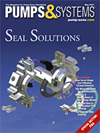Insight and reactions to key industry coverage
"Circulation Systems for Single and Multiple Seal Arrangements (Part One)," May 2007
Click here for full article.
 If installing an orifice on seal flush system, which way should the chamfer face? Facing pressure or downstream?
If installing an orifice on seal flush system, which way should the chamfer face? Facing pressure or downstream?
Bruce
Ralph Gabriel responds
The chamfer would be on the low pressure side or downstream.
"The History of Pumps," January 2012
Click here for the full article.
 I was handed your January issue of Pumps & Systems by my son who is in the pump business.
I was handed your January issue of Pumps & Systems by my son who is in the pump business.
I read your article on “The History of Pumps” with interest since I am a retired pump engineer who spent my entire career in the engineered pump industry. Some of those names mentioned are very familiar to me, knowing them from Hydraulic Institute meetings.
I was surprised that your article did not recognize Harry LaBour who founded LaBour Pumps, Inc. He was a pioneer in developing pumps for the chemical industry. He developed corrosion resistant alloys to incorporate in his pumps. Until his time, sulfuric acid was always pumped with lead pumps, the only known material that would handle certain concentrations of the acid.
He developed Elkomet-K (alloy 20) before Mars Fontanna developed it for Duriron. That would handle only certain concentrations of sulfuric acid, so he went on to develop his R-55 alloy that would handle concentrations and temperatures that Alloy 20 would not. He went on to develop other alloys, 17 in all, poured in his own foundries. He was truly a pioneer in the corrosion and pump industry.
Not only that, he developed the first centrifugal self-priming pump and even developed a vertical self-priming pump that had no seal at the shaft. Unfortunately, he was a man who did not like attention, so many of his attributes were not common knowledge, but some people that contributed to your article should have known.
It was a lot of work for you to find all the dates and stories of happenings, and I found it very enjoyable reading.
C. J. Hahn
Michelle Segrest responds:
Thank you for this great information. Other industry professionals also contacted me about Harry LaBour’s accomplishments. We have included some of this information in our expanded online coverage of “The History of Pumps” on www.pump-zone.com.
"Pump Ed 101," March 2012
Click here for the full article.
 Your well-crafted articles are always interesting to read. On page 20 in the March issue of P&S, under "Pump Performance", the first two sentences of the second paragraph read:
Your well-crafted articles are always interesting to read. On page 20 in the March issue of P&S, under "Pump Performance", the first two sentences of the second paragraph read:
"Pump efficiency also increases with pump rotational speed, especially high speeds. The increase is not as pronounced at 3,600 rpm and below."
Are these sentences referring to hydraulic prototype-model laws and a Moody-type efficiency equation? If the pump size is not changed, wouldn't the pump efficiency remain fairly constant at different speeds per the affinity laws? What am I missing?
Lee Ruiz
Joe Evans responds:
The high speed I mentioned referred to model laws or efficiency equation. What I was trying to say was that very low-volume, high-head centrifugal pumps can exhibit relatively high efficiency when operated at high speeds.
For example, I saw a small pump at a show that was designed for an application that could not use a positive displacement pump. Flow was 20 gallons per minute at 2,000-foot head, and the rotational speed was over 20,000 rpm.
